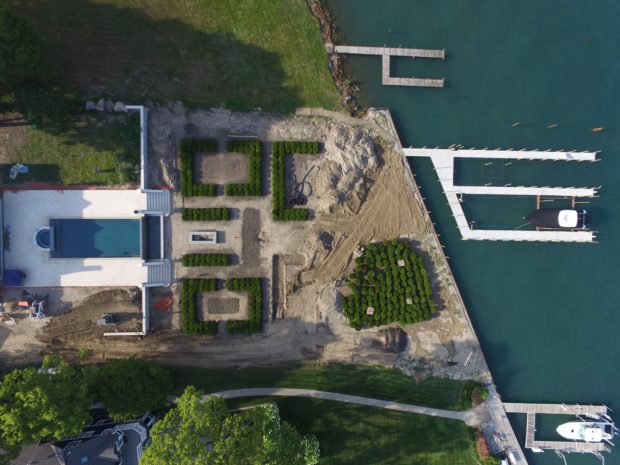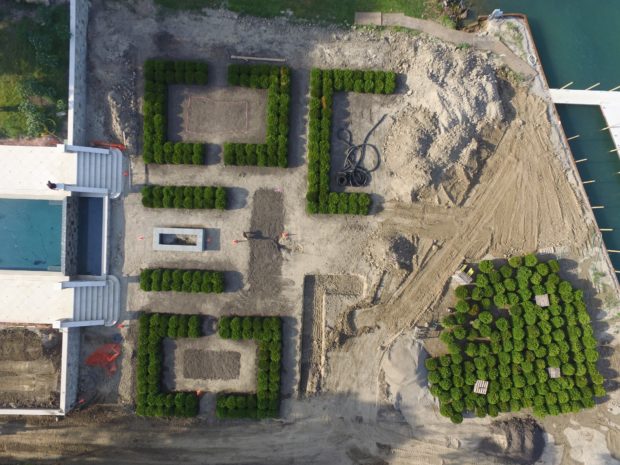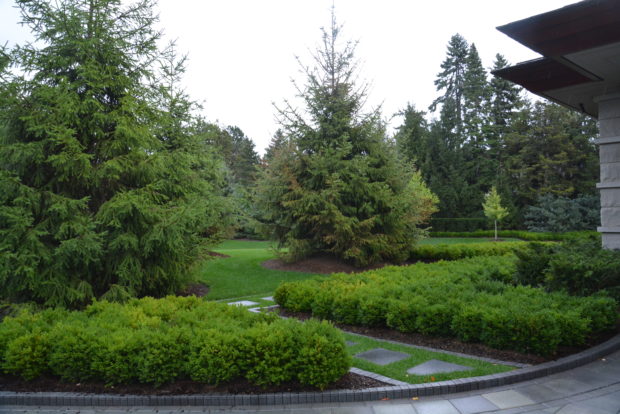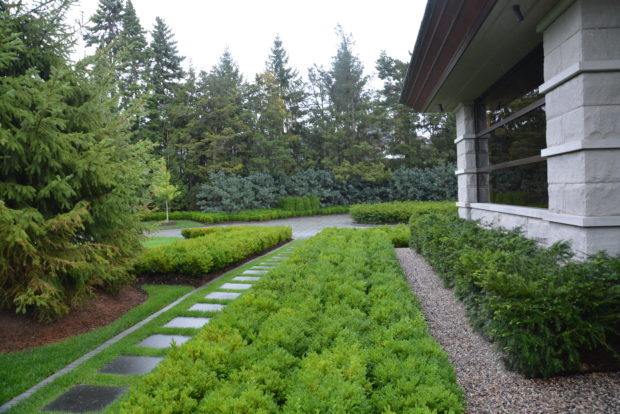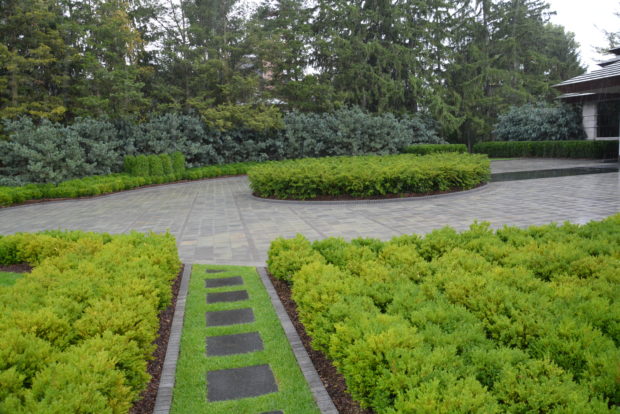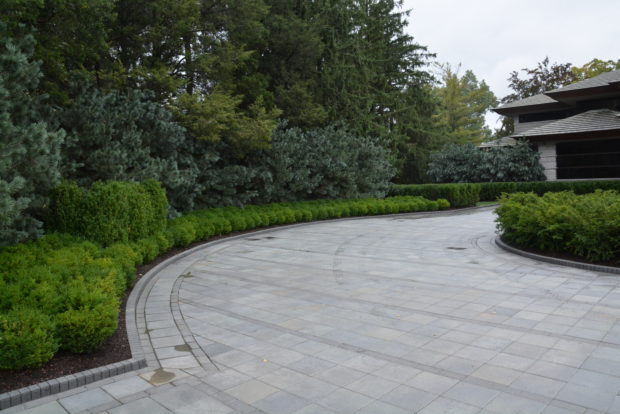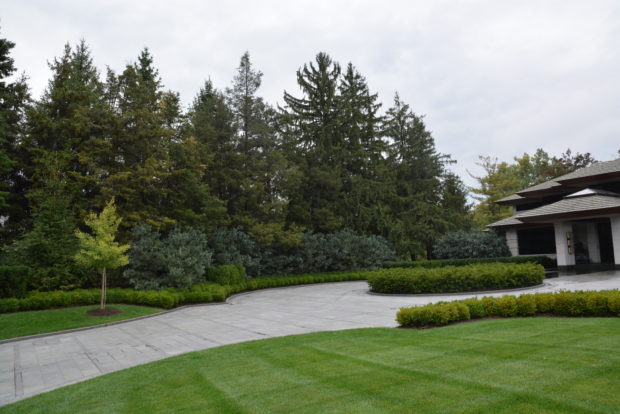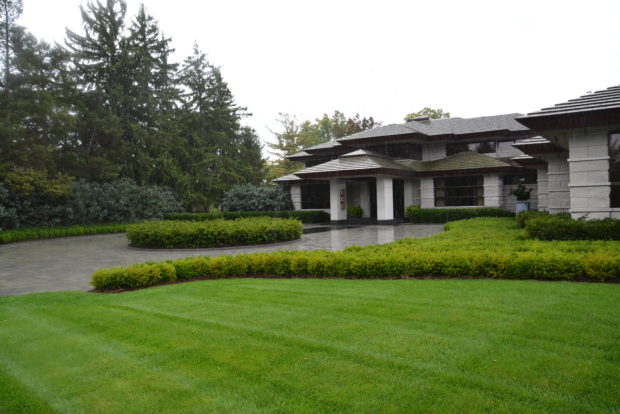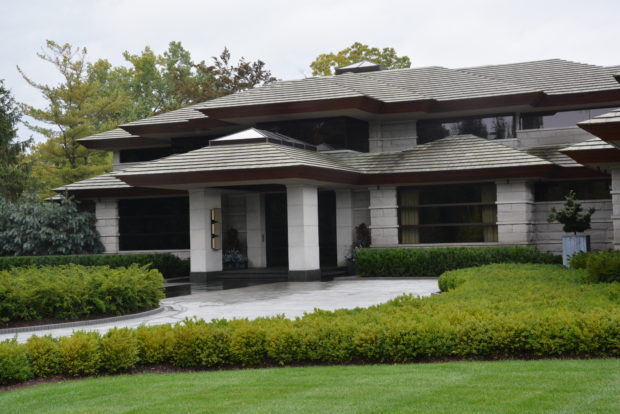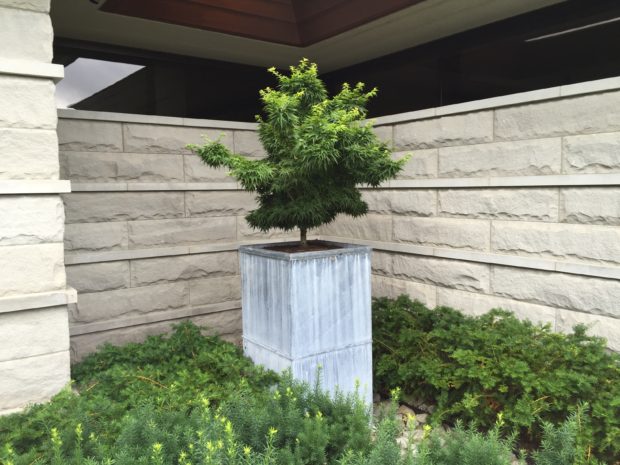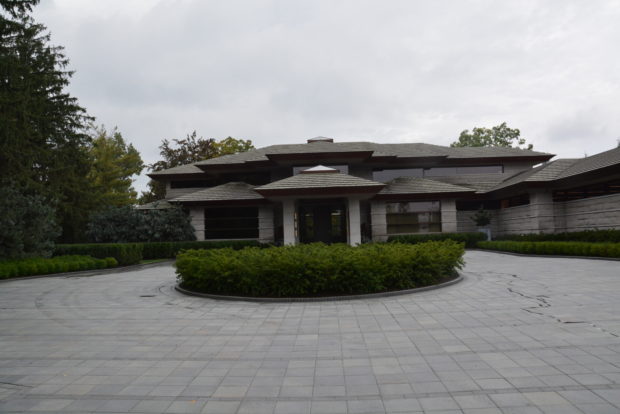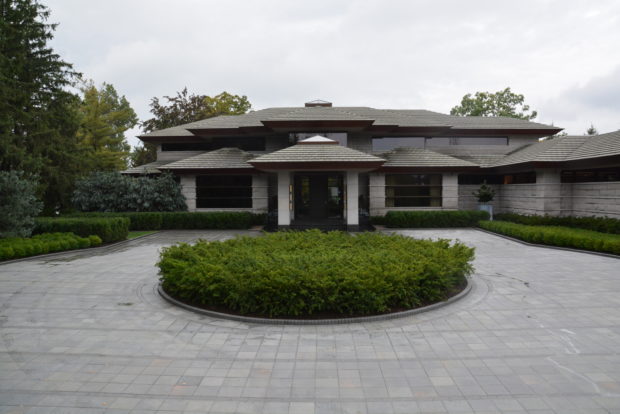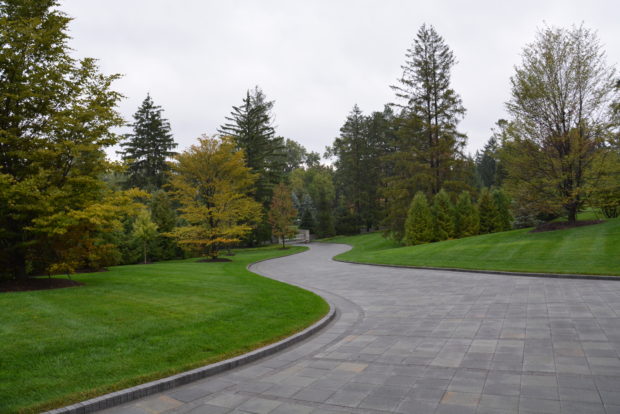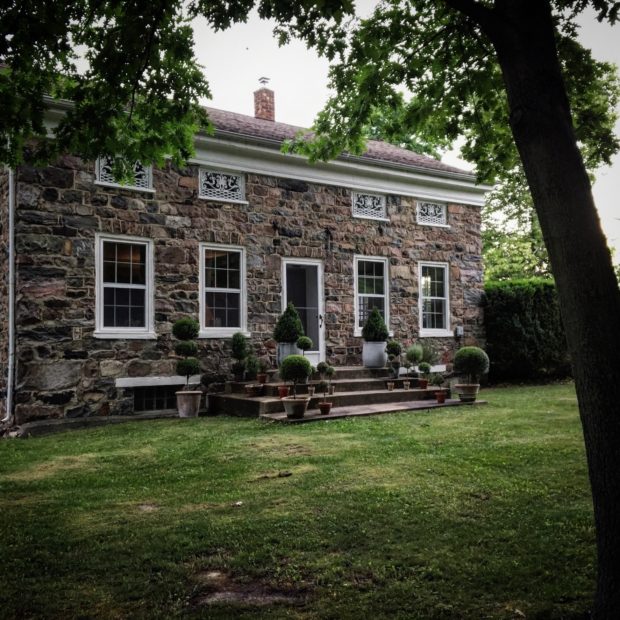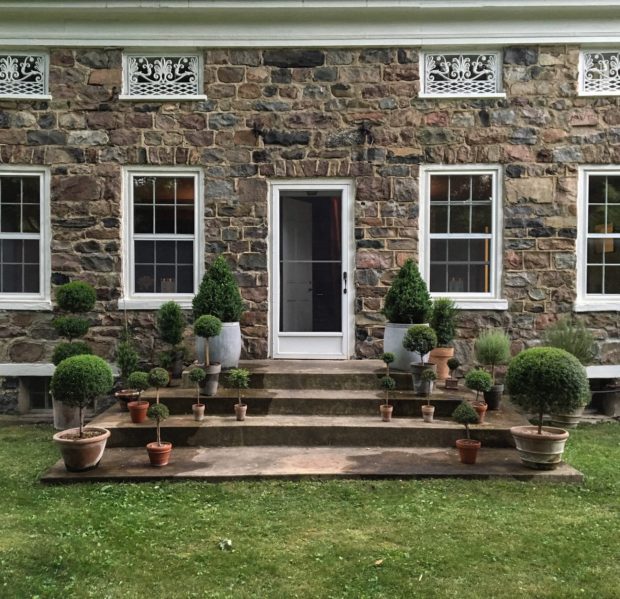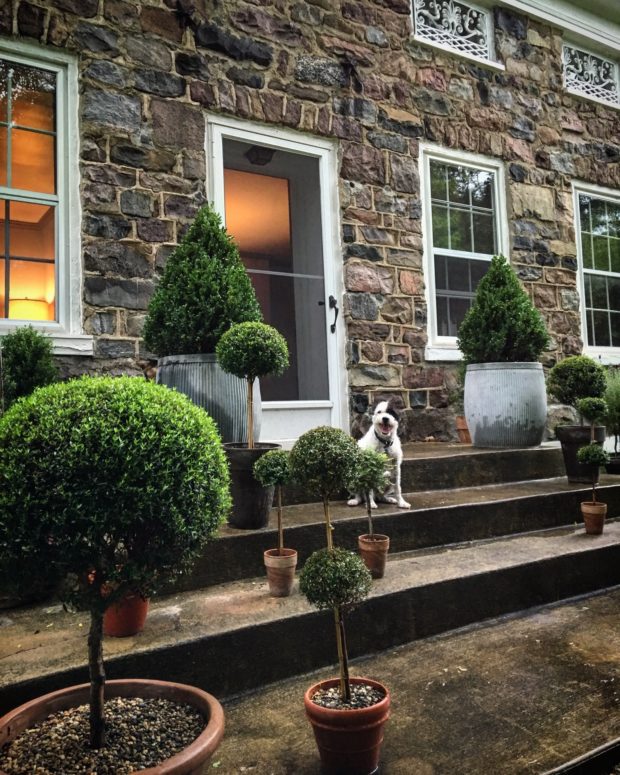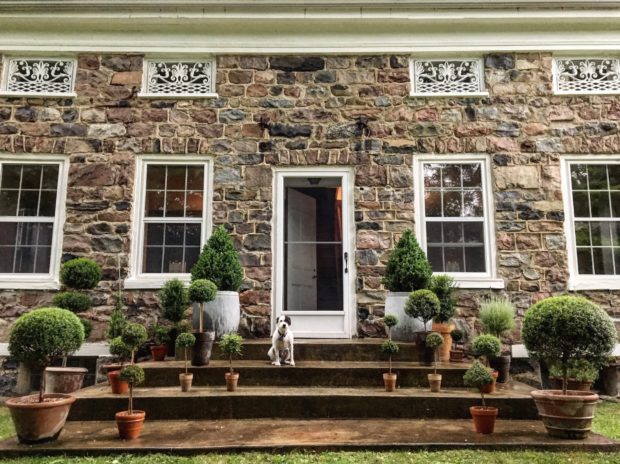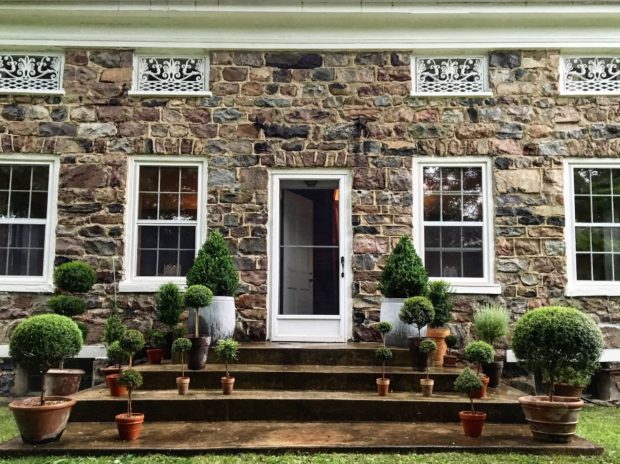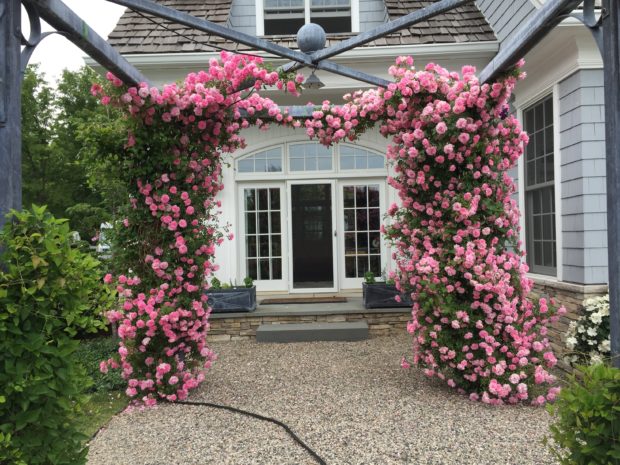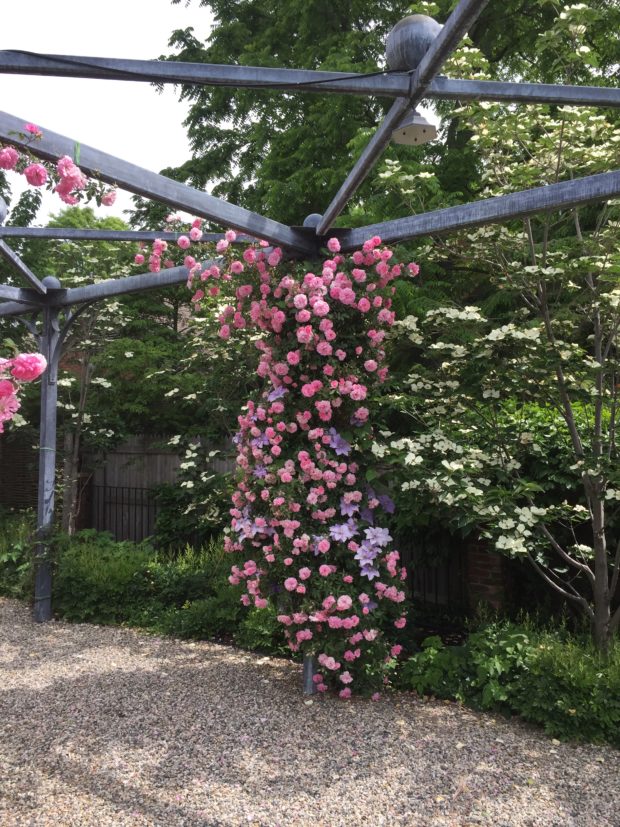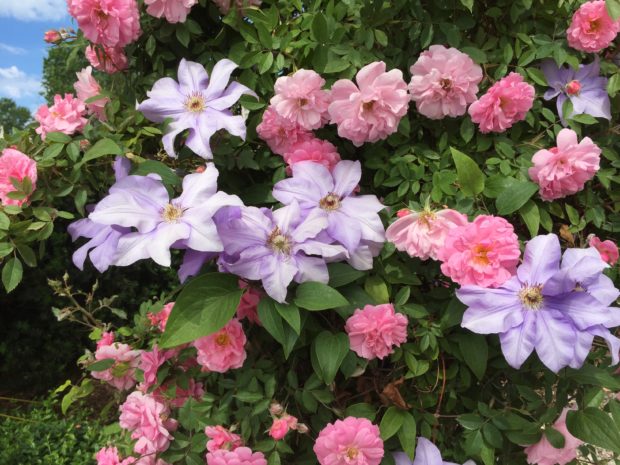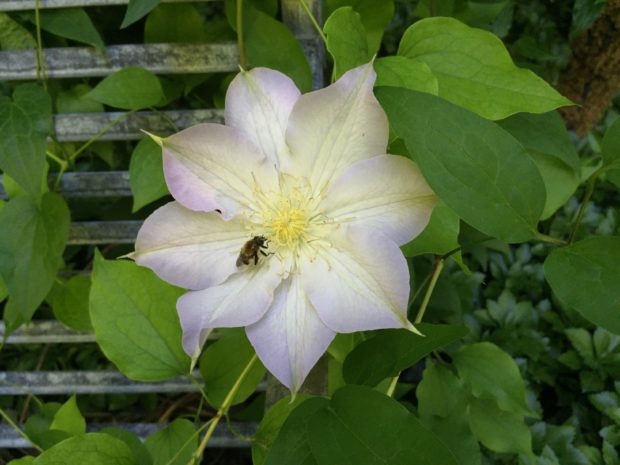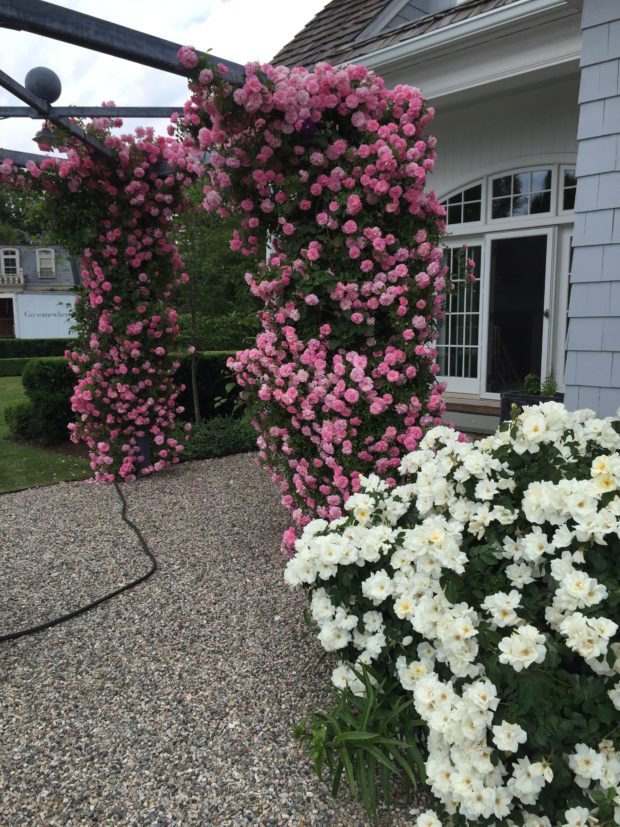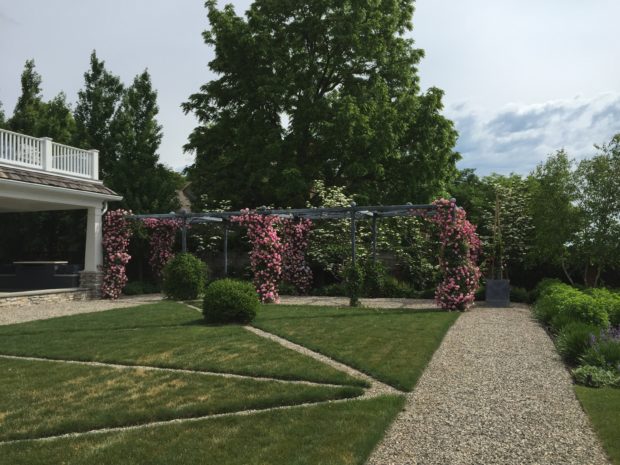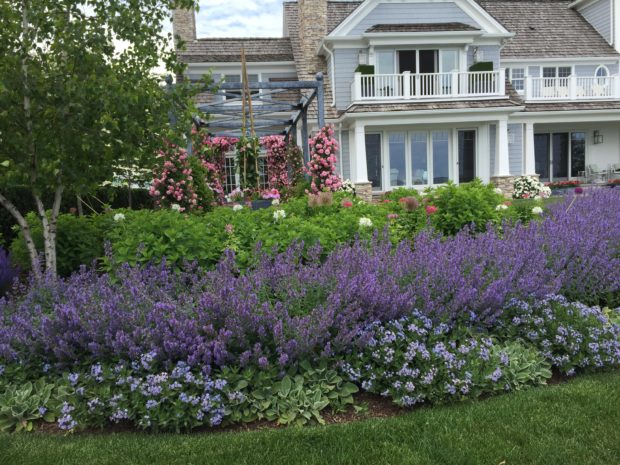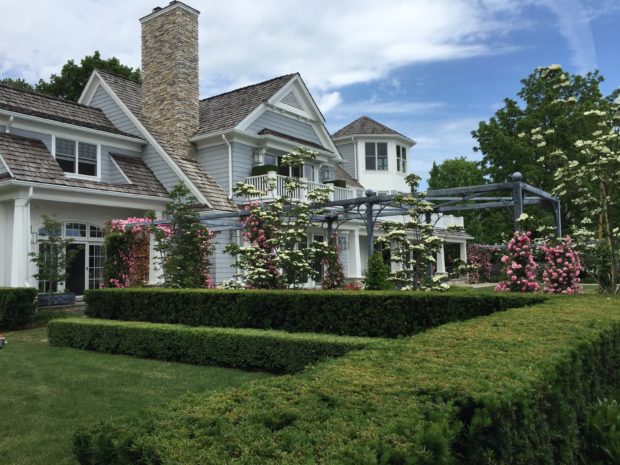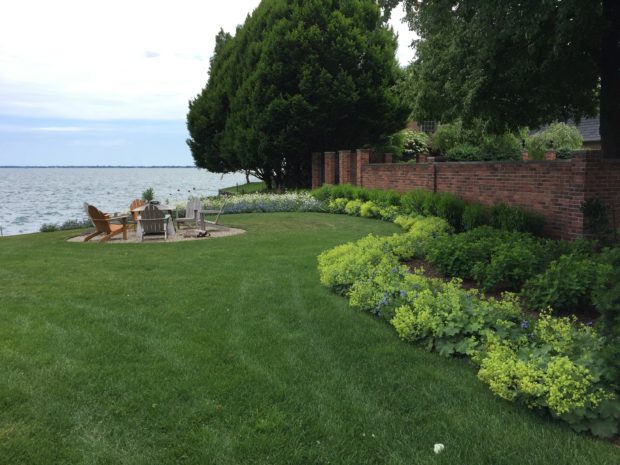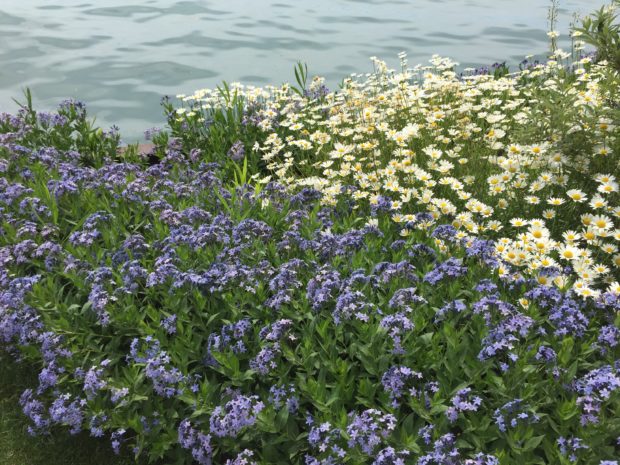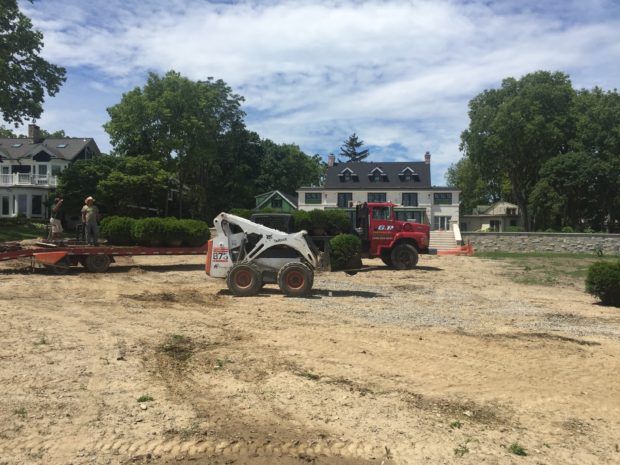 My last two posts about this project might make you suspect that my primary interest in this landscape has to do with hard structures. Not so. The hard structures just need to be installed first, as they set the grade and determine the location of all of the plantings to come. I can move a tree or shrub-but not a swimming pool. Every landscape project is governed by those immutable issues. A driveway, a fire hydrant, a house, a city sidewalk, an electrical pole, a stone terrace – these landscape elements are fixed, for better or for worse. Every landscape contractor on a new house or extensive renovation project would prefer to have the immutable elements established up front. A landscape installation of this size requires an order of events. Hard structures, first. Once the new dock, retaining walls, pool and pool terrace were done, it was our turn. GP Enterprises plants all of my big trees for me. They have an installation of trees going on in the front yard of this project which I will get to later. Once it was time to transport 420 36″ diameter Green Gem boxwood from my yard to a project over an hour away from our yard, GP stepped up and sent two trucks, 2 trailers, and 4 of his people to give me a hand. It took 8 people, 4 trucks, and two days to bring the boxwood due to be installed in the back yard to the site. My client texted me late that day, “Welcome home, boxwood”. Loved that from her.
My last two posts about this project might make you suspect that my primary interest in this landscape has to do with hard structures. Not so. The hard structures just need to be installed first, as they set the grade and determine the location of all of the plantings to come. I can move a tree or shrub-but not a swimming pool. Every landscape project is governed by those immutable issues. A driveway, a fire hydrant, a house, a city sidewalk, an electrical pole, a stone terrace – these landscape elements are fixed, for better or for worse. Every landscape contractor on a new house or extensive renovation project would prefer to have the immutable elements established up front. A landscape installation of this size requires an order of events. Hard structures, first. Once the new dock, retaining walls, pool and pool terrace were done, it was our turn. GP Enterprises plants all of my big trees for me. They have an installation of trees going on in the front yard of this project which I will get to later. Once it was time to transport 420 36″ diameter Green Gem boxwood from my yard to a project over an hour away from our yard, GP stepped up and sent two trucks, 2 trailers, and 4 of his people to give me a hand. It took 8 people, 4 trucks, and two days to bring the boxwood due to be installed in the back yard to the site. My client texted me late that day, “Welcome home, boxwood”. Loved that from her.
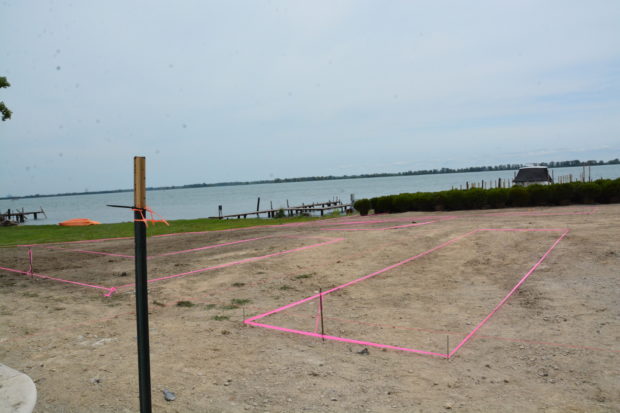 She knew the back story. Though we had procured the plants, and were ready to plant last fall, a fall planting proved to be out of the question. A new dock installation was beset with problems and significant delays. The stonework on the retaining walls took weeks and more weeks. It looked as though the entire back yard was filled with big trucks, and pallets of stone. Bad weather helped to seal the deal. Late last fall, all 420 of these boxwood were moved inside my landscape building, and set on top of 6″ of mulch spread over the concrete floor, for the winter. Why the mulch layer over the concrete floor? Concrete can absorb and draw the moisture out of a root ball. A dry plant coming out of winter storage would most surely be a dead plant. The effort was worth it. These 420 strong survived the winter indoors without any problem, but a very cold and relentlessly rainy spring pushed our installation date back much further than I ever imagined. Once the middle of May arrived, I knew this installation would need to be pushed into July. The day I finally had those boxwood on site was a day many months in the making. Dan and his crew measured and set the dig lines. We only needed to make one small change. 10 inches to the south. The walls and stairs had been built very close to the measurements called out on the plan. We went over and over the lines. It took less than 2 hours for me to sign off on the layout.
She knew the back story. Though we had procured the plants, and were ready to plant last fall, a fall planting proved to be out of the question. A new dock installation was beset with problems and significant delays. The stonework on the retaining walls took weeks and more weeks. It looked as though the entire back yard was filled with big trucks, and pallets of stone. Bad weather helped to seal the deal. Late last fall, all 420 of these boxwood were moved inside my landscape building, and set on top of 6″ of mulch spread over the concrete floor, for the winter. Why the mulch layer over the concrete floor? Concrete can absorb and draw the moisture out of a root ball. A dry plant coming out of winter storage would most surely be a dead plant. The effort was worth it. These 420 strong survived the winter indoors without any problem, but a very cold and relentlessly rainy spring pushed our installation date back much further than I ever imagined. Once the middle of May arrived, I knew this installation would need to be pushed into July. The day I finally had those boxwood on site was a day many months in the making. Dan and his crew measured and set the dig lines. We only needed to make one small change. 10 inches to the south. The walls and stairs had been built very close to the measurements called out on the plan. We went over and over the lines. It took less than 2 hours for me to sign off on the layout.
 Once every line was set and checked, the planting would be underway. This is a very formal and geometric landscape. The precision of the layout took a good bit of time, as it should. Insuring that they would be planted in the right place involved a lot of stakes and lines, and twice as many measurements. Once a boxwood went in to the ground, I would be very unhappy at the prospect of having to move it. My crew would be even more unhappy. Each root ball weighs 235 pounds. Sliding a 235 pound root ball into place is vastly less work than lifting 235 pounds out of the ground.
Once every line was set and checked, the planting would be underway. This is a very formal and geometric landscape. The precision of the layout took a good bit of time, as it should. Insuring that they would be planted in the right place involved a lot of stakes and lines, and twice as many measurements. Once a boxwood went in to the ground, I would be very unhappy at the prospect of having to move it. My crew would be even more unhappy. Each root ball weighs 235 pounds. Sliding a 235 pound root ball into place is vastly less work than lifting 235 pounds out of the ground.
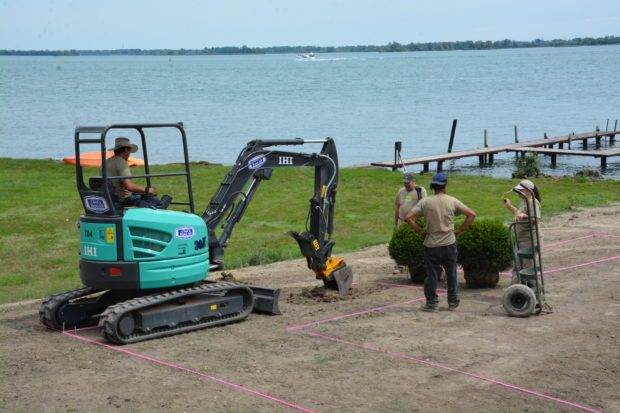 It was not my idea to dig individual holes for each boxwood. Oh no. We dug overscales trenches with an excavator that would allow us to place and level each double row of boxwood. Our 420 boxwood were graded at 36″ tall, by 36″ wide. But that grading is a loose business. Some were taller, and shorter. Others were flatter, or more ball shaped. Some were decidedly lopsided. Of course we would sort through and select the plants that would be neighborly in shape and height. The oversized trenches would permit moving the boxwood this way and that, up and down, in service of the precision asked for by the design. A planting of this scale and scope asks for some mechanical help. We use our front end loader frequently, but I rarely have a need for an excavator. Dan decided to rent that machine for a month. That proved to be an excellent decision. We were able to spend more time on the plant selection, placement, and planting, and less time hand digging.
It was not my idea to dig individual holes for each boxwood. Oh no. We dug overscales trenches with an excavator that would allow us to place and level each double row of boxwood. Our 420 boxwood were graded at 36″ tall, by 36″ wide. But that grading is a loose business. Some were taller, and shorter. Others were flatter, or more ball shaped. Some were decidedly lopsided. Of course we would sort through and select the plants that would be neighborly in shape and height. The oversized trenches would permit moving the boxwood this way and that, up and down, in service of the precision asked for by the design. A planting of this scale and scope asks for some mechanical help. We use our front end loader frequently, but I rarely have a need for an excavator. Dan decided to rent that machine for a month. That proved to be an excellent decision. We were able to spend more time on the plant selection, placement, and planting, and less time hand digging.
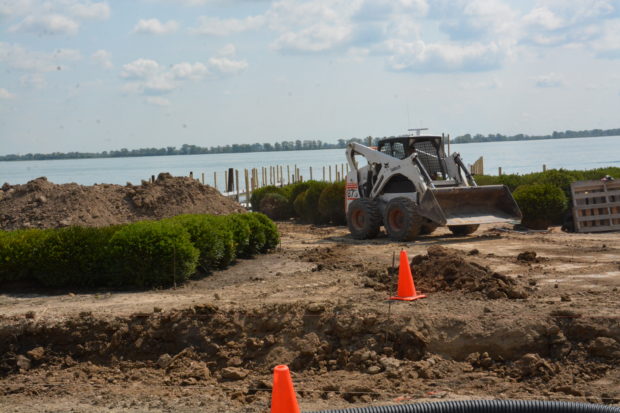 The contrast between the boxwood and bare dirt was extraordinary. I was so pleased to see these gorgeous plants going in to the ground. Welcome home boxwood, indeed.
The contrast between the boxwood and bare dirt was extraordinary. I was so pleased to see these gorgeous plants going in to the ground. Welcome home boxwood, indeed.
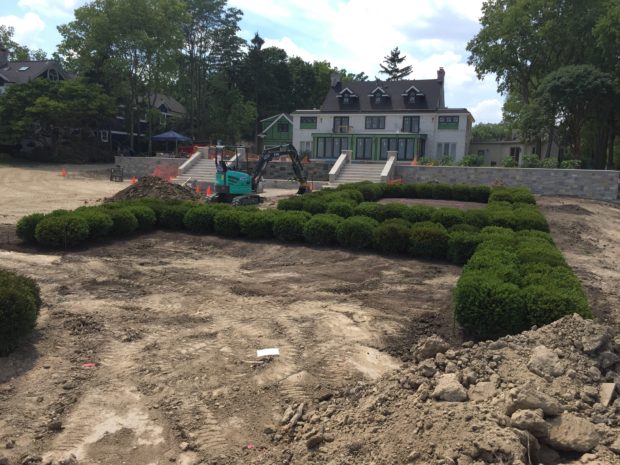 Once Dan had a day under his belt, he was able to establish an approach to the work that would make the best use of everyone’s time, and move the project forward in the most efficient way possible. He would plant the entire south side, before moving to the north.
Once Dan had a day under his belt, he was able to establish an approach to the work that would make the best use of everyone’s time, and move the project forward in the most efficient way possible. He would plant the entire south side, before moving to the north.
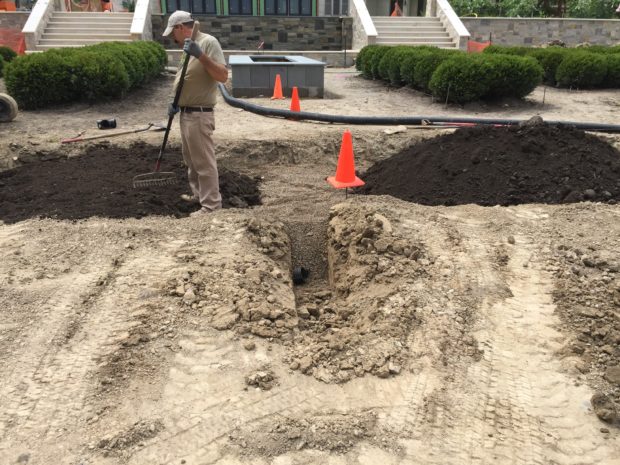 The plan calls for three gardens. I find that woody plant material is much more easy going regarding conditions than perennials. I have planted countless shrubs and trees and seen them readily adapt to their home. Perennials are much more sensitive to poor living conditions. Dan saw fit to provide 18″ of good soil, and install drainage for good measure.
The plan calls for three gardens. I find that woody plant material is much more easy going regarding conditions than perennials. I have planted countless shrubs and trees and seen them readily adapt to their home. Perennials are much more sensitive to poor living conditions. Dan saw fit to provide 18″ of good soil, and install drainage for good measure.
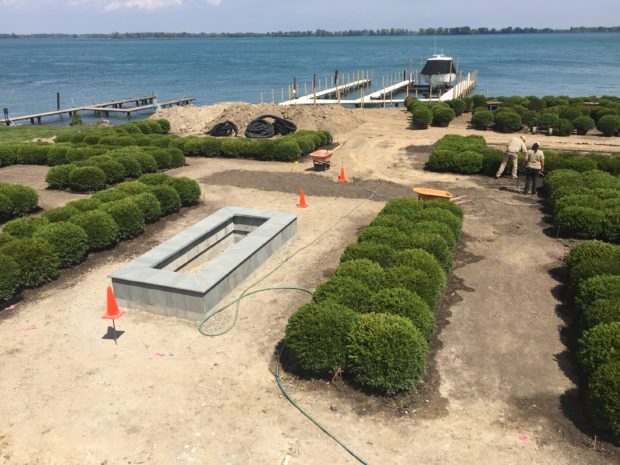 I suppose it is time to discuss the design for this part of the property. This lower terrace is the mid ground space from the house looking out to the river. Dan took this picture from the upper pool terrace level. It is clear that the landscape not only needed to be proportional to the size of the property, and the walls and stairs, it needed to read from a distance. The second floor of the house is slated for a large terrace situated on the roof of the rear porch. The view from that upper level balcony is an important view. An every day view. It will be a beautiful view, no matter the season or the weather. These boxwood are massive, and the shapes designed are simple and on an appropriately large scale. Their formal arrangement is in beautiful contrast to the amorphous quality of the water, and the wild landscape in the distance. As a mid ground feature, it introduces and enhances the views out. The views from the river towards the house would be equally dramatic. A 14 foot long gas firepit whose flames will be enclosed by glass will provide a place for my clients and their friends to gather and relax. The bluestone coping is set at seat height. Glass enclosing the flames? This is a very windy location.
I suppose it is time to discuss the design for this part of the property. This lower terrace is the mid ground space from the house looking out to the river. Dan took this picture from the upper pool terrace level. It is clear that the landscape not only needed to be proportional to the size of the property, and the walls and stairs, it needed to read from a distance. The second floor of the house is slated for a large terrace situated on the roof of the rear porch. The view from that upper level balcony is an important view. An every day view. It will be a beautiful view, no matter the season or the weather. These boxwood are massive, and the shapes designed are simple and on an appropriately large scale. Their formal arrangement is in beautiful contrast to the amorphous quality of the water, and the wild landscape in the distance. As a mid ground feature, it introduces and enhances the views out. The views from the river towards the house would be equally dramatic. A 14 foot long gas firepit whose flames will be enclosed by glass will provide a place for my clients and their friends to gather and relax. The bluestone coping is set at seat height. Glass enclosing the flames? This is a very windy location. 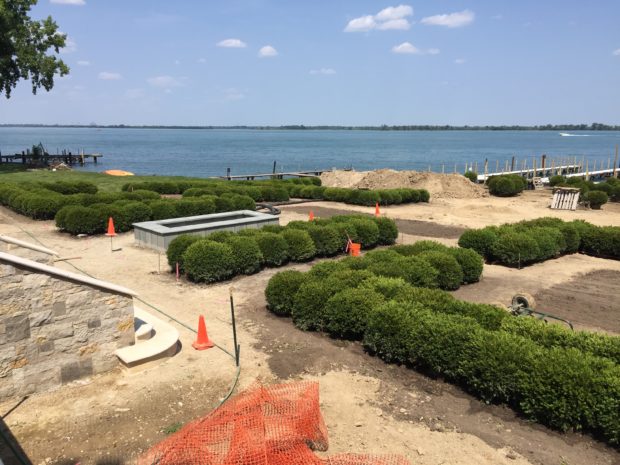 My clients expressed an interest in the classical and formal landscape. They were interested in gardens, and the seating to go with. They went so far as to tell me that the landscape part of their renovation to their home and property would be their favorite. They were interested in places they could view from afar, and places they could be. They wanted to live outdoors exuberantly, and entertain privately.
My clients expressed an interest in the classical and formal landscape. They were interested in gardens, and the seating to go with. They went so far as to tell me that the landscape part of their renovation to their home and property would be their favorite. They were interested in places they could view from afar, and places they could be. They wanted to live outdoors exuberantly, and entertain privately.
 These pictures taken from the upper level do not express the enclosure and intimacy created on the ground floor by the boxwood. Once my clients and their company are seated in this lakeside garden, they will have a quiet and private place to be. Given the many conversations I have had with them, I understand that they want strong and beautiful views from afar, and intimacy and enclosure up close. The design is my response to that request.
These pictures taken from the upper level do not express the enclosure and intimacy created on the ground floor by the boxwood. Once my clients and their company are seated in this lakeside garden, they will have a quiet and private place to be. Given the many conversations I have had with them, I understand that they want strong and beautiful views from afar, and intimacy and enclosure up close. The design is my response to that request.
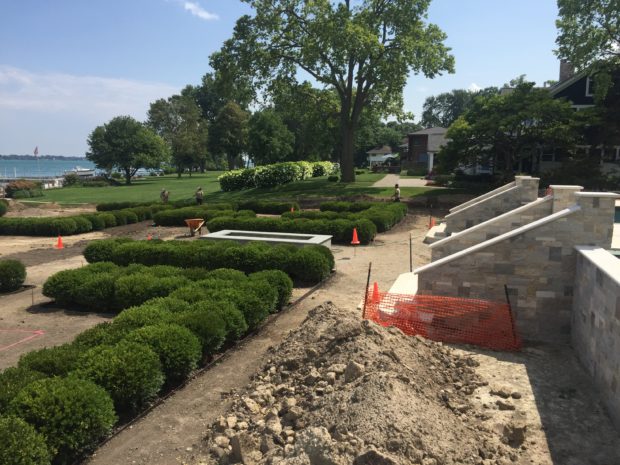 This view from the south towards the north does not describe the gardens to come. But it does do a good job of describing the structure of the landscape.
This view from the south towards the north does not describe the gardens to come. But it does do a good job of describing the structure of the landscape.
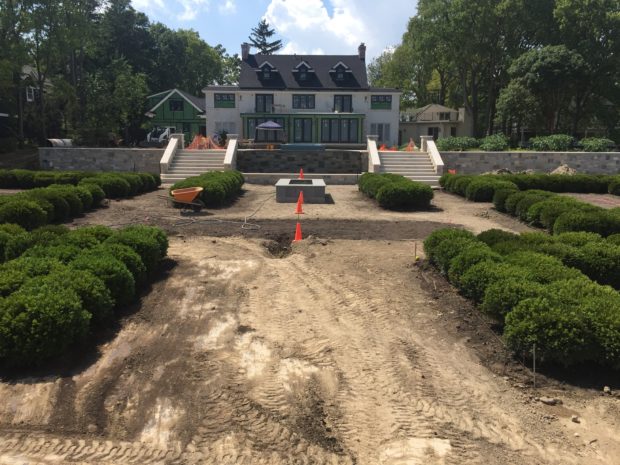 I do believe that the first step with any landscape design is to establish some structure. I have the idea that my relationship with these clients is a long term relationship. What we have done here is a giant first step. But a first step, nonetheless. I am certain I will hear more from them, as the landscape progresses. Who knows where we will be in 5 years. I do favor an initial landscape design that is all about creating some structure. Any client that wants to go beyond establishing that initial structure will let me know. To follow are drone pictures taken by my clients from last week.
I do believe that the first step with any landscape design is to establish some structure. I have the idea that my relationship with these clients is a long term relationship. What we have done here is a giant first step. But a first step, nonetheless. I am certain I will hear more from them, as the landscape progresses. Who knows where we will be in 5 years. I do favor an initial landscape design that is all about creating some structure. Any client that wants to go beyond establishing that initial structure will let me know. To follow are drone pictures taken by my clients from last week.
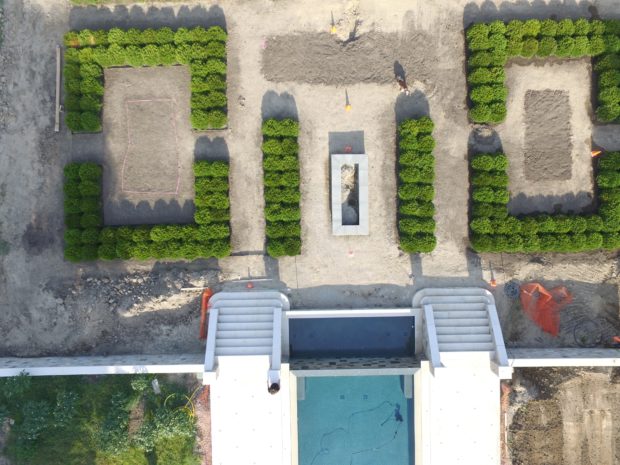 As Mary Keen says, “Nostalgia in gardening often surfaces as a longing for that older, deeper relationship between person and place that we rarely achieve in modern life.”
As Mary Keen says, “Nostalgia in gardening often surfaces as a longing for that older, deeper relationship between person and place that we rarely achieve in modern life.”
